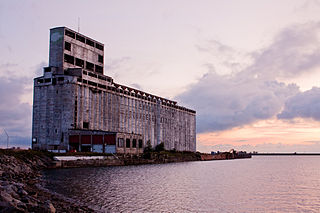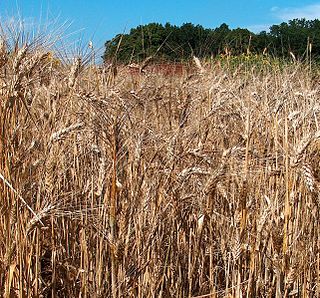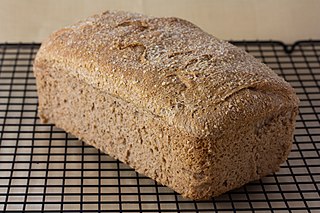
Panicum miliaceum is a grain crop with many common names including proso millet, broomcorn millet, common millet,, hog millet, Kashfi milletred millet, and white millet,. Archeological evidence suggests that crop was first domesticated before 10,000 BCE in Northern China. The crop is extensively cultivated in China, India, Nepal, Russia, Ukraine, Belarus, the Middle East, Turkey, Romania, and the United States, where approximately half a million acres are grown each year. The crop is notable both for its extremely short lifespan, with some varieties producing grain only 60 days after planting, and its low water requirements producing grain more efficiently per unit of moisture than any other grain species tested. The name "proso millet" comes from the pan-Slavic general and generic name for millet Croatian: proso). Proso millet is a relative of foxtail millet, pearl millet, maize, and sorghum within the grass sub-family Panicoideae. While all of these crops utilize C4 photosynthesis, the others all employ the NADP-ME as their primary carbon shuttle pathway while the primary C4 carbon shuttle in proso millet is the NAD-ME pathway.

A threshing machine or thresher is a piece of farm equipment that threshes grain, that is, it removes the seeds from the stalks and husks. It does so by beating the plant to make the seeds fall out.

The oat, sometimes called the common oat, is a species of cereal grain grown for its seed, which is known by the same name. While oats are suitable for human consumption as oatmeal and rolled oats, one of the most common uses is as livestock feed. Oats are a nutrient-rich food associated with lower blood cholesterol when consumed regularly.

Rye is a grass grown extensively as a grain, a cover crop and a forage crop. It is a member of the wheat tribe (Triticeae) and is closely related to barley and wheat (Triticum). Rye grain is used for flour, bread, beer, crisp bread, some whiskeys, some vodkas, and animal fodder. It can also be eaten whole, either as boiled rye berries or by being rolled, similar to rolled oats.

Flour is a powder made by grinding raw grains or roots and used to make many different foods. Cereal flour is the main ingredient of bread, which is a staple food for most cultures. Wheat flour is one of the most important ingredients in Oceanic, European, South American, North American, Middle Eastern, North Indian and North African cultures, and is the defining ingredient in their styles of breads and pastries.

A grain elevator is an agrarian facility complex designed to stockpile or store grain. In grain trade, the term grain elevator also describes a tower containing a bucket elevator or a pneumatic conveyor, which scoops up grain from a lower level and deposits it in a silo or other storage facility.

Chaff is the dry, scaly protective casings of the seeds of cereal grain, or similar fine, dry, scaly plant material such as scaly parts of flowers, or finely chopped straw. Chaff is indigestible by humans, but livestock can eat it and in agriculture it is used as livestock fodder, or is a waste material ploughed into the soil or burned.

Durum wheat, also called pasta wheat or macaroni wheat, is a tetraploid species of wheat. It is the second most cultivated species of wheat after common wheat, although it represents only 5% to 8% of global wheat production. It was developed by artificial selection of the domesticated emmer wheat strains formerly grown in Central Europe and the Near East around 7000 BC, which developed a naked, free-threshing form. Like emmer, durum wheat is awned. It is the predominant wheat that grows in the Middle East.
Wheat flour is a powder made from the grinding of wheat used for human consumption. Wheat varieties are called "soft" or "weak" if gluten content is low, and are called "hard" or "strong" if they have high gluten content. Hard flour, or bread flour, is high in gluten, with 12% to 14% gluten content, and its dough has elastic toughness that holds its shape well once baked. Soft flour is comparatively low in gluten and thus results in a loaf with a finer, crumbly texture. Soft flour is usually divided into cake flour, which is the lowest in gluten, and pastry flour, which has slightly more gluten than cake flour.

The germ of a cereal is the reproductive part that germinates to grow into a plant; it is the embryo of the seed. Along with bran, germ is often a by-product of the milling that produces refined grain products. Cereal grains and their components, such as wheat germ oil, rice bran oil, and maize, may be used as a source from which vegetable oil is extracted, or used directly as a food ingredient. The germ is retained as an integral part of whole-grain foods. Non-whole grain methods of milling are intended to isolate the endosperm, which is ground into flour, with removal of both the husk (bran) and the germ. Removal of bran is aimed at producing a flour with a white rather than a brown color, and eliminating fiber, which reduces nutrition. The germ is rich in polyunsaturated fats and so germ removal improves the storage qualities of flour.

Pastiera napoletana is a type of Neapolitan tart made with cooked wheat, eggs, ricotta cheese, and flavoured with orange flower water. It is usually eaten at Easter.

A whole grain, also called a wholegrain, is a grain of any cereal and pseudocereal that contains the endosperm, germ, and bran, in contrast to refined grains, which retain only the endosperm.
The grain trade refers to the local and international trade in cereals and other food grains such as wheat, maize, and rice.

Species belonging to the genus Amaranthus have been cultivated for their grains for 8,000 years. Amaranth plants are classified as pseudocereals that are grown for their edible starchy seeds, but they are not in the same botanical family as true cereals such as wheat and rice. Amaranth species that are still used as a grain are Amaranthus caudatus L., Amaranthus cruentus L., and Amaranthus hypochondriacus L. The yield of grain amaranth is comparable to rice or maize.
Aegilops cylindrica, also known as jointed goatgrass. is an annual grass seed that is part of the tribe Triticeae, along with wheat and some other cereals. It is not native to the United States, however it has become a serious issue as a weed since it was introduced in the late 19th century. Due to its relation to winter wheat, it is very difficult to control. Not only are the joints similar in shape and size to the seeds of winter wheat, making it difficult to remove through grain cleaning methods, the shared genetics mean that no registered herbicides are available to single out jointed goatgrass while leaving winter wheat unharmed. This poses problems for farmers who have to suffer through reduced yields and poorer quality winter wheat.

Mote is the generic name for several varieties of corn grains boiled, consumed in many regions of South America. It is usually prepared by boiling the grains in water made alkaline by the addition of ashes or lime, a process known as nixtamalization.

Whole wheat bread or wholemeal bread is a type of bread made using flour that is partly or entirely milled from whole or almost-whole wheat grains, see whole-wheat flour and whole grain. It is one kind of brown bread. Synonyms or near-synonyms for whole-wheat bread outside the United States are whole grain bread or wholemeal bread. Some regions of the US simply called the bread wheat bread, a comparison to white bread. Some varieties of whole-wheat bread are traditionally coated with whole or cracked grains of wheat, though this is mostly decorative compared to the nutritional value of a good quality loaf itself.
In agriculture, grain quality depends on the use of the grain. In ethanol production, the chemical composition of grain such as starch contents is important, in food and feed manufacturing, properties such as protein, oil and sugar are significant, in milling industry soundness is the most important factor to consider and for seed producer, the high germination percentage and seed dormancy is the important feature to consider, for consumers the properties like color and flavor will be important.
















